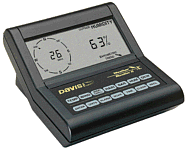

Riverland Internet installed an electronic weather station, a Weather Monitor II from Davis Instruments. We're in Renmark, in the Riverland area of South Australia. It continues to operate with the support of the Murray Pioneer and Riverland Web & Email Services.

You can see the current weather at Renmark. There are also some records and graphs.
The weather station has sensors for temperature and humidity (inside and outside), wind speed and direction, rainfall and barometric pressure. It also records the maximum and minimum values of these quantities, with the time and date they occurred. These are archived every half hour, and we now have several years' records. The weather station also calculates wind chill and dew point, using the current weather information.
The weather station is connected to our webserver, and we get updated information from it about every minute. If you want to see an update (a minute later), click the Reload or Refresh button in your browser.
If you need easier access to weather information than that, maybe you need your own weather station.
The weather station's sensors are located at the Murray Pioneer building, on Ral Ral Avenue, Renmark.
The weather station itself is inside the building, so the inside temperature and humidity would only tell you about our air-conditioning.
The outside temperature and humidity sensors are in a shaded, ventilated position under the roof.
The rain gauge is on the roof, in an un-sheltered position.
The anemometer (shown at left) measures wind speed and direction. It is located on a mast, above the roof of the building. There are some high trees nearby which probably shield it: the Bureau's automatic weather station at Renmark aerodrome often shows stronger wind than our weather station. (Any pilot can tell you that the wind is always stronger at the airport.)
Our weather station does not meet the standard conditions that the Bureau of Meteorology requires for official weather observations. However, we compared our readings with the Bureau's when they were nearby, and we were rarely more than a degree of temperature different.
In July 2002 the BoM stopped taking weather readings in Renmark township (see story in Pioneer). The readings that BoM publish as Renmark observations are now taken at Renmark airport, which is about 8 km from the town. Since that move we've noticed that our temperatures are often warmer than theirs. Another story in the Pioneer has some explanation, and mentions that the BoM airport site is less sheltered than their old one in the township.
As an example: at 6am on 7 June 2006, the BoM read -2.2 C at the airport. Our weather station read 5.8 C, and a different thermometer in the same position agreed. With the second thermometer, I couldn't find any area near the Pioneer building that was colder than 3 C.
We would like to add more sensors - more weather stations - to the information displayed here. There will be more work done on the graphs and records. If you have any other suggestions for our weather pages, we would be interested to hear them - you can email us at this address
(Since we didn't get the crystal ball option with the weather station, we can't forecast the weather - the Bureau of Meteorology is still your best bet for forecasts.)
Wind chill is a measure of how cold you would feel outside, exposed to the wind. If there is a strong wind blowing, this can be quite a bit colder than the temperature!
Dew point is the temperature at which dew would begin to form, if some air with the current temperature, humidity and pressure were cooled. If the dew point is close to the temperature, cloud and fog are not far away. If they are the same, we would be in a fog.
Wind run is the distance a chunk of air travelled in a whole day. Wind speed (e.g. 8 km/hour) is how far it travelled in one hour - wind run is how far in 24 hours. Our weather pages show wind run in the monthly summaries.
Chill units are the number of hours for which the temperature was below 7 degees celsius. This value is used by some fruitgrowers - if there aren't enough chill units, the fruit doesn't "set". Chill units are shown in our monthly summaries.